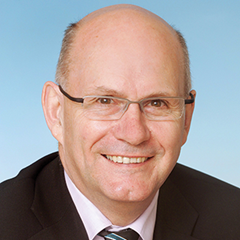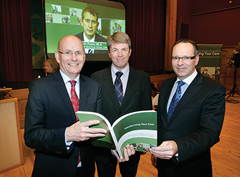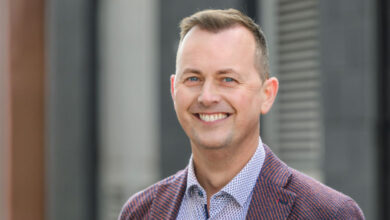Transforming health: John Compton
 In a wide-ranging interview, Health and Social Care Board Chief Executive John Compton discusses the future vision of health and social care in Northern Ireland with Owen McQuade. Care will shift from hospitals to the community and should be tailored to better meet the needs of the individual.
In a wide-ranging interview, Health and Social Care Board Chief Executive John Compton discusses the future vision of health and social care in Northern Ireland with Owen McQuade. Care will shift from hospitals to the community and should be tailored to better meet the needs of the individual.
A “challenging and daunting” task awaited the health and social care review team, according to the Transforming Your Care document’s introduction. Published in December 2011, the report formed the basis of a major ministerial statement and public consultation on the draft plans on service changes to implement Transforming Your Care. That consultation has now closed, and over 2,000 responses were received. A further ministerial statement is expected once the analysis of these is completed.
John Compton, the Chief Executive of the Health and Social Care Board, chaired the review and is looking forward to the new challenge of rolling out the final changes.
Change in health and social care is firstly driven by an ageing population. “In a way, that’s a good thing because it’s an acknowledgement that as a society, many people are living longer,” he states. “The majority of people live very successfully and healthily longer but it does increase the proportion of people who have chronic conditions and need care and support.”
Most patients in a typical general medical ward will be older people and, indeed, it’s unusual to have a young person in hospital.
The evidence base is the second biggest driver. Health and social care staff increasingly know what delivers the best outcome and quality of care and they want to look at evidence in a much more robust way: “Irrespective of whether people agree with how you organise health and social care, when it comes to them personally, they expect whenever they see a health and social care professional that they’re getting the best.”
Neo-natal units with 50 children, for example, tend to have better outcomes, over the long term, than those with less than 50. Further on in life, a child growing up in a care facility will have “profoundly different” life opportunities than one receiving foster care.
The third key driver is how the workforce is organised so that services are sustainable. “The last thing in the world anybody wants is to have a service constantly under pressure,” he comments. The European Working Time Directive brought in a 48-hour working week for doctors-in-training in August 2009. The training of professional groups has changed dramatically over the last 5-10 years and will change again over the next 5-10 years.
In terms of finance, he adds: “Any society that’s delivering health and social care has to have a serious debate about the proportion that it can afford to spend on health and social care, and what I think it reasonably expects is that you use the money as effectively as you can.”
Rather than an argument about the system not having enough money, he wants to see people thinking about how they use the money that the service has: “It’s like winning the lottery on Saturday night: rollover £10-12 million and it’s spent by tea-time on Sunday. That’s the reality for health and social care in Northern Ireland.”
Expectation is another factor. Northern Ireland has a much more educated and informed population than before and members of the public expect those services to be responsive and more available. “When you put all of that combination together, what it really tells you is that while we’ve got a system that’s done a pretty decent job for Northern Ireland, if you just leave it as it is, it’s going to fall off the rails: not tomorrow morning but five years down the line, ten years down the line.”
Change in health and social care has to be thought through on a three-to-five or five-to-eight year timescale otherwise “you can find yourself overwhelmed by problems.”
In practice, the future model of health and social care will maintain people close to or in their home. This is what most people want, the evidence shows that it results in better outcomes and the service can deliver that in a new way.
“If you have a long-term condition, the vast majority of your care will be in or close to home,” Compton comments. “If we do things differently, you may have to be in hospital once or twice a year but not six or seven times a year, and that’s better for you.”
To return to the workforce driver, this means making the professionals responsible for delivering services in a more straightforward way e.g. intravenous antibiotics, renal dialysis or care for the older person.
An individual should only have to share their life story once and should also know that “you have more choice and more control over what happens to you.” When considering a 15-hour per week care package, the client and his or her carer should be able to say “this is what makes my life work” and have that care arranged in a way that suits their needs.
The ideal result is individualisation (as opposed to one-size-fits-all) which will form part of a radical transformation from acute to primary care. Compton sums up the change as:
• a shift towards community;
• better use of our hospital services; and
• a recognition that no hospital “is an island unto itself” and each hospital “has to work in a network.”
‘Transforming Your Care’ foresees a reduction of 180 beds across Northern Ireland and a 5 per cent shift in funding (about £80 million) from hospital services to community services over three to five years. Transitional funding will “effect the change before you move the money” and £70 million has been requested. That investment is already taking place in 2012-2013 and will be in place through to 2014-2015.
Hospitals are there to provide care and treatment to populations. Traditional thinking has focused on building a large institution, which people come and use. The new paradigm says: “Here’s a population. What are the needs of this population?” and then asks what a hospital network supporting that population would look like, and shapes the network accordingly.
The bowel cancer screening programme is one example of a population-centred approach. This is costing £2 million to set up but will prove cost-effective by discovering the early signs of a treatable disease and “qualitatively, for them and their family, clearly a much better outcome.”
Asked if a 5 per cent shift is radical enough, Compton recalls a significant lesson he has learned over the years: “If you’re going to make a fairly significant change, balance and proportion are really, really important. I’m sure I can make the argument for more than 5 per cent but I also have to balance that with deliverability.”
He predicts that the shift will pick up momentum if it is achieved in the right way. “It is a stretching ask to start off with and if you can do better, do better,” he continues. “I would much prefer to suffer the accusation of under-promising and over-delivering as opposed to over-promising and under-delivering.”
Priorities
While the solutions are now well-understood, the health and social care system forms a large sector which needs clear priorities if that change is to be delivered. Asked for priorities, Compton points to those outlined in the ‘vision to action’ document:
• reshaping primary care through integrated care partnerships;
• networking hospitals;
• continuing the resettlement programme for people with learning disabilities and mental health difficulties;
• a new model of care for older people at home; and
• preventative health care, especially for children.
‘Shift left’ is a common phrase used by the Health and Social Care Board and means “moving the investment back to stop the problem.” Compton elaborates: “The old adage is true: an ounce of prevention is worth a pound of cure. It’s about just getting the prevention correct, both at a primary and secondary level.”
A “big effort” in ante-natal healthcare and among vulnerable groups of mothers-to-be helps to avoid problems later in life: “We can’t promise that this is going to fix everything but we can do better.”
Secondary prevention takes place when a person develops a disease as care at that point ‘arrests’ the worst implications of that disease. Honest communication is particularly important in this area.
The health and social care system’s job is “to help inform you about what’s the best thing to do” as far as a person’s personal health is concerned. The individual’s job is to “take that on board and do the sensible thing.” Most people, in his view, will listen and take better informed choices and decisions, which in turn is “important for us as a society as well.”
Seven-day week
The re-configuration of acute services, it is put to him, will be a difficult change process. “Anytime that I particularly talk about change, people say: ‘Oh, you’re making cuts,’” he remarks. “This is nothing to do with cuts. We haven’t been asked to save any money out of this.”
Re-organisation is about culture and changing traditional patterns of behaviour and practices, to make a radical shift to a seven-day week. The status quo is a “five plus two week” where every service runs Monday to Friday but weekend services run on emergency or on-call arrangements.
Senior staff and junior staff will be scheduled to work in physical buildings across all seven days of the week. This reform reflects society’s expectations: “You can go and do your Tesco’s shopping on a Sunday afternoon. Why can’t you go and have an out-patient appointment on a Sunday afternoon?”
Flexibility in the workforce is “very key” but it also underlines the need to have a strong commitment to staff through training staff, explaining what managers are trying to do, and providing good leadership.
“These things don’t happen by accident. By and large we’re fortunate, I think, in the health and social care system because we have got a good workforce,” Compton reflects. “They’re committed people. They’ve chosen to work in health and social care. It’s not a job for everybody. They’ve made a big commitment to work in it and they want it to be successful.”
On the culture of health and social care, he notes that “the care bit of it is good” and a strong caring ethic can be built upon. However, at times, the system can be “traditional” in its practices.
Health and social care, though, is no different from any other large organisation going through a major restructure and is not immune from those problems.
Integrated care partnerships
The success of the integrated care partnerships is “absolutely critical”. It is proposed that seventeen of these will be set up across Northern Ireland, bringing together the full range of health and social care services in each geographic area, including the independent and voluntary sector.
“If you really are serious about wanting to enable people to be cared for and treated at or close to home, then the professionals who work in the community are going to be central to that,” he states.
Aligned to that, he wants older people to know that “we really can provide care better” whether that is support in someone’s own home or care at the end of their lives.
He knows situations where care for older people has worked “brilliantly” but others where it hasn’t worked so well and he has a personal ambition to improve on that. At an ethical level, he sees care for vulnerable older people as one of the “touchstones” which determine whether a society is a good place to live in.
The interview took place a week before the consultation closed on 15 January. The board sought to gather the views of as many people as possible through 16 public meetings, meetings with groups, podcasts and a facebook page. It also sent a leaflet to every household across Northern Ireland.
Compton was “genuinely humbled” to hear the common sense views of people taking part at the events. He found that they liked the direction of travel but were also concerned about the impact on some local services and feared that the changes involved “privatising” the system.
“Nothing could be further from the truth,” he contends. “This whole thing is built profoundly on the core principles of health and social care.”
Modernising mental health services
The shift from hospital to community services in mental health is “going well” with a lot of home support systems now put in place and major reductions in the number of admissions.
“Admission to a psychiatric hospital is not a neutral event in people’s lives,” Compton explains. People tend to be “reinforcing or sympathetic” to a person admitted for a physical injury or complaint but less so if they are admitted for serious depression or schizophrenia.
Northern Ireland will still have six mental health units but these will be closer to larger acute sites to emphasise that there is no difference between physical and mental illnesses.
The modern quality of accommodation in new units is starkly better than that in old ‘traditional’ units. A good quality environment “accelerates recovery” and leads to fewer re-admissions, which is clearly important for families.
Electronic care record from April
Technology is a “hugely important” area in the change process. Within the system, technology oscillates between the leading edge and the very basic. Users can book appointments on the internet in some places but that service is not available across the board.
The Department of Health, Social Services and Public Safety and the Department of Enterprise, Trade and Investment are jointly promoting Northern Ireland as a European reference site for testing health technology.
The electronic care record will be rolled out from April this year and will be accessed by GPs and hospital clinicians. People expect that a doctor will be able to bring all their medical records on a computer: “It’s not about exposing your life. It’s about information that’s pertinent about the reason you’re there.”






